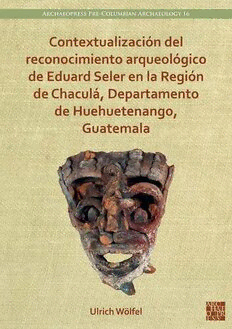
Contextualización del reconocimiento arqueológico de Eduard Seler en la Región de Chaculá, Departamento de Huehuetenango, Guatemala PDF
416 Pages·2022·57.465 MB·Spanish
Most books are stored in the elastic cloud where traffic is expensive. For this reason, we have a limit on daily download.
Preview Contextualización del reconocimiento arqueológico de Eduard Seler en la Región de Chaculá, Departamento de Huehuetenango, Guatemala
Description:
This study re-examines and contextualises Eduard Seler's investigations in the Chaculá-Region (Department of Huehuetenango, Guatemala). Starting with a discussion of ethnohistory as well as the historical circumstances of Seler's research, his methods are critically examined in the context of archaeology in late 19th century Guatemala and the practice of collecting by European museums, specifically the Ethnological Museum Berlin. This is followed by the results of a reconnaissance of the different archaeological sites documented by Seler in the region, in which their current state of preservation is examined and Seler's excavation trenches are re-discovered. The core of the work is a new study of the materials from the region in the collection of the Ethnological Museum Berlin, including previously undocumented ceramic materials. Through typological cross-dating, a first ceramic chronology for the region is established, showing that the major settlements were occupied from the Late Classic (600-900) to the Early Postclassic (900-1250). These data and observations form the foundation for a re-examination of the interpretations put forth by Eduard Seler and later scholars, concerning topics such as architecture, burials and caches, the function of the Quen Santo caves, ritual and settlement continuity from the Late Classic to modern times and the ethnolinguistic identity of the ancient inhabitants of the region. The book concludes with a look at the postcolonial challenges that the collection in Berlin faces and ways to connect the archaeological past with the indigenous present in the Chaculá-Region.,El estudio reexamina y contextualiza las investigaciones de Eduard Seler en la región de Chaculá (Departamento de Huehuetenango, Guatemala). Empezando con una discusión de la etnohistoria, así como las circunstancias históricas de las investigaciones de Seler, sus métodos son examinados de manera crítica en el contexto de la arqueología en la Guatemala a finales del siglo XIX y la práctica de coleccionar de museos Europeos, específicamente el Museo Etnológico de Berlín. A esto siguen los resultados de un reconocimiento de los diferentes sitios arqueológicos documentados por Seler en la región, en que su estado actual de preservación es examinado y las trincheras de las excavaciones de Seler son redescubiertas. El núcleo de la obra constituye un nuevo estudio de los materiales procedentes de la región en la colección del Museo Etnológico de Berlín, incluyendo materiales cerámicos anteriormente no documentados. A través de un fechamiento tipológico cruzado, se establece una primera cronología cerámica para la región, mostrando que los asentamientos principales fueron ocupado entre el Clásico Tardío (600-900 d.C.) hasta el Posclásico Temprano (900-1250 d.C.). Estos datos y observaciones forman el fundamento para una reevaluación de la interpretaciones avanzadas por Eduard Seler e investigadores posteriores, respecto a temas como arquitectura, entierros y escondites, la función de las cuevas de Quen Santo, continuidad de rituales y asentamientos desde el Clásico Tardío hasta tiempos modernos y la identidad etnolingüística de los antiguos habitantes de la región. El libro concluye con una mirada de los retos poscoloniales que enfrenta la colección en Berlín y maneras de conectar el pasado arqueológico con el presente indígena en la región de Chaculá.
See more
The list of books you might like
Most books are stored in the elastic cloud where traffic is expensive. For this reason, we have a limit on daily download.
